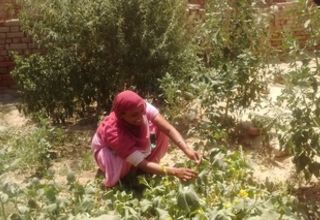Sukhpreet Kaur, RodiKapura Village, Faridkot District

Sukhpreet Kaur, is in her mid 20s from a landless household. Their livelihood depends on working as hired farm labour. Recently they have also set up a small shop outside their house selling everyday groceries. They also tried farming on 12 acres of leased land. They sowed cotton and guar beans, but had to incur losses and went into a debt of Rs 2 lakhs. So they gave up on cultivation. She says, “On the leased land we were farming with chemicals and therefore the input costs were very high. The yield was not as much as the costs of production.”
She started cultivating vegetables in a small plot in her household yard since the beginning of summer. She says, “I do all the work on the vegetable plot myself. On the first attempt there was no yield, then I tried again. The KVM activist guided me on how to go step by step and taught me the proper methods. First of all she told me which are the summer season vegetables. So we got those seeds from the market. Then we applied manure on the plot, and then applied a mixture of certain boiled leaves before sowing the seeds, to increase soil fertility and strength. Then after ploughing, we sowed the seeds. This time there has been good yield. But there was a severe pest attack as well. I made an organic spray and the pests were controlled. I have harvested guar beans, pumpkins, various kinds of gourds, cucumber and chillies once this season. Now they are ready to be harvested a second time. The vegetables have been sufficient for our household consumption needs. We do not have to buy anything from the market.”
“Looking after the vegetable plot does not take up that much time every day, it has not increased my workload significantly. Usually, in the mornings I get up and feed the cattle, then fill water. We have a small shop. I help out there and there are everyday chores of cooking and cleaning. I manage to find some time to look after the vegetables, to keep track of any pests or other diseases. Most of my time though goes in attending to the shop where we sell groceries. That is also my responsibility. Before opening the shop we had tried farming on rented land just once. But we do not farm anymore because it was very expensive and we ran into losses. Our source of livelihood before we tried farming was mostly daily wage labour on farms or through MGNREGA. MGNREGA work is available only for 15 days in a year even though it is supposed to be 100 days. There has been a lot of uproar and many people went complained to the sarpanch but nothing has changed. I have gone personally. We also have a MGNREGA committee in the village. Fifteen days work means hardly any money in a year. On top of that the payments are delayed for a whole year. The work generally involves cleaning water channels and minor repair work. Many women go outside the village to pick cotton with their husbands. I have only picked cotton within the village though. But more and more farmers are not sowing cotton anymore, which means less work for us. In any case cotton picking lasts for about two months in a year. My husband works in transplanting paddy as well, but that also lasts for about 1.5 months. During the winter there is no work available for wage labour.
“Growing vegetables at home appealed to me because we would be able to meet our own consumption needs with good quality vegetables. I am able to save a lot of money. In addition to saving money, eating vegetables that are grown without harmful chemicals is beneficial to our health as well. So I decided to do it. I can see that it has a made a difference in terms of health even in such a short time. I have started growing vegetables only this season. But even before that I had started getting vegetables grown without chemicals from someone else’s house. The pain in my joints has subsided to a large extent. I will definitely continue to grow vegetables at home as it saves a lot of money.”